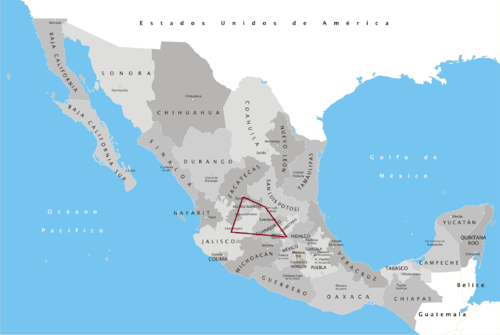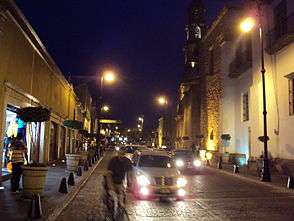Bajío
The Bajío (lowlands) is a region of Central Mexico that includes parts of the states of Aguascalientes, Jalisco (Centro-Los Altos de Jalisco), Guanajuato, and Querétaro.[1][2][3][4][1]

The Bajío has repeatedly been recognized as the region with the best quality of life, the safest region,[5] and the most dynamic in Mexico, sometimes credited that in Latin America too.[6][7][8][9] Nowadays, the region is a economically vigorous service industry-oriented region that is experiencing an ongoing socioeconomic revitalization. [10][11][12] The largest cities of Bajio are Guadalajara, León, Santiago de Querétaro and Aguascalientes.[13]
History of Bajío culture

Recent archaeological studies of the Bajío have discovered an extensive, historic cultural tradition unique to the region, particularly along the flood plains of the Lerma and Laja rivers. The Bajío Culture flourished from 300 to 650 CE, with cultural centers ranging from El Cóporo in the far north of Guanajuato to Plazuelas in the far south west.[14] More than 1,400 sites have been discovered throughout the state of Guanajuato, with only the sites of Cañada de la Virgen, El Cóporo, Peralta, and Plazuelas having received extensive study. This region was also known as La Gran Chichimeca in later years. It was the epicenter of the historic Chichimeca War, the Northern Revolutionary States, and cradle of Mexican War of Independence.
Geography
In general usage, the region is usually associated with the States of Guanajuato and Querétaro, even though those two states form a part of the Bajío. It is now characterized by its highly mechanized agriculture, with mean precipitation in the order of 700 millimeters (28 in) per annum (one of the highest in the country). During the Viceroyalty of New Spain, the area was known as the breadbasket of the territory. As of 2014, the region produces sorghum, wheat and maize as its main crops.
The Bajío region lies in the basin of the Rio Lerma and Río Grande de Santiago.
States
The free and sovereign states of the Bajío are:
| Aguascalientes |
Guanajuato |
Jalisco |
Querétaro |
 |
 |
 |
 |
| Aguascalientes | Guanajuato | Guadalajara | Querétaro |
State of Aguascalientes
State of Jalisco
- Guadalajara
- Lagos de Moreno
- Tepatitlán de Morelos
- San Juan de los Lagos
- Arandas
Demography

Largest cities
| Rank | City | State | Population | Metro Area |
|---|---|---|---|---|
| 1 | Guadalajara | Jalisco | 1,530,817 | 4,664,212 |
| 2 | León | Guanajuato | 1,436,480 | 1,609,717 |
| 3 | Aguascalientes | Aguascalientes | 934,424 | 1,025,432 |
| 4 | Santiago de Querétaro | Querétaro | 801,940 | 1,097,025 |
| 5 | Irapuato | Guanajuato | 380,941 | 529,979 |
| 6 | Celaya | Guanajuato | 310,413 | 468,387 |
| 7 | Salamanca | Guanajuato | 160,169 | 260,732 |
| 8 | Lagos de Moreno | Jalisco | 153,817 | 164,212 |
| 9 | San Juan del Río | Querétaro | 138,878 | 402,112 |
| 10 | Tepatitlán de Morelos | Jalisco | 104,377 | 288,635 |
| 11 | Silao | Guanajuato | 74,242 | 147,123 |
Economy
Today, the region is one of the fastest-growing in the country. This has caused the metropolitan areas to attract many migrants from other parts of Mexico.[15][16][17]
The region has had an outstanding industrial and economic development in the last 15 years. The cities of Bajío have one of the highest income per capita in Mexico.[18]
The Bajío is home to numerous World Heritage Sites, attracting investors, tourists, and migrants. World Heritage Sites:
- San Miguel de Allende
- Sanctuary of Jesús Nazareno de Atotonilco
- Franciscan Missions in the Sierra Gorda
- Agave Landscape and Ancient Industrial Facilities of Tequila
- Hospicio Cabañas
- Guanajuato City
- Zacatecas City
- Querétaro City
Asian community
As of early 2014, there are more than three thousand Japanese immigrants in the Bajío area, and it is claimed that this population is larger than the historical Japanese community in Mexico City.[19] The Guanajuato government believes that by 2016 there will be five thousand families living in the area.[20] This immigration is being driven by foreign investment in the area, especially in the automotive sector.
By the end of 2014, it is expected that there will be 100 families settled in Querétaro. In the capital of Querétaro there are 50 Japanese restaurants, 15 of which opened in 2013, mainly in the area of Juriquilla and new shopping centers. There are also talks of the Liceo Mexicano Japonés opening a campus in Querétaro.[20] Bajío Shimbun is a monthly, Japanese-language newspaper founded in June 2015.[21] The first Japanese consulate in Mexico was inaugurated in January 2016 in León and will serve the Bajío region.[22] As of 2017, there were 1,143 Japanese in Aguascalientes, 43% of all foreigners in the state.[23]
There is also a Korean community in the area that is likewise growing as a result of foreign investment. As of 2014, it was more common to see Korean students in private schools than it was to see Japanese.[20]
High-speed rail in the Bajío
There are plans to build a high-speed rail link between Querétaro and Mexico City, which would continue to Guadalajara. It would work as the main form of transportation in all the Bajío and its capital cities.[24]
Culture
The Bajío is known for being the cradle of Mexican Independence from Spanish Empire and one of the most conservative bastions of Mexican Catholicism.
The Bajío is where in April 1915, during the Mexican Revolution, General Álvaro Obregón provoked decisive battles against Pancho Villa. Villa's troops lost in June outside Celaya.
See also
References
- "Microsoft Word - DTE-550" (PDF). Retrieved 2018-07-18.
- "Entrada Group: at the heart of Mexico's thriving manufacturing industry". European CEO. January 10, 2014. Retrieved September 19, 2015.
- Ruiz Méndez, Karla (January 4, 2014). "Se afianza en el Bajío clúster de autopartes". Periódico AM (in Spanish). Retrieved September 19, 2015.
- "Caen 2.5% las remesas familiares en el Bajío". El Financiero (in Spanish). January 7, 2014. Archived from the original on January 16, 2014. Retrieved September 19, 2015.
- "Archived copy". Archived from the original on 2013-10-21. Retrieved 2014-09-07.CS1 maint: archived copy as title (link)
- "Economía - Noticieros Televisa". Noticieros Televisa.
- Cruz, Osiel (16 August 2013). "Bajío, el nuevo milagro mexicano".
- "Estados del Bajío crecen a ritmo asiático: Banamex".
- "El Bajío crece a ritmo de tigre asiático". www.elfinanciero.com.mx.
- "Developing Mexico's Bajio Region". Stratfor.
- "In Mexico, a New Manufacturing Heartland?". Stratfor.
- "As Mexico's Commercial Real Estate Soars, Second Tier Cities Attract First-Rate Attention - Nearshore Americas". 16 June 2014.
- "The Bajío Guide - Mexico Travel". Rough Guides.
- Butzer, Karl and Elisabeth Butzer. 1997. “The Natural Vegetation of the Mexican Bajío: Archival Documentation of a Sixteenth Century Savannah Environment.” Quaternary International 43, no. 4: 161-72.
- "Junto Con El Crecimiento De La Ciudad, Crecen También Los Servicios Públicos Municipales Con Calidad En Beneficio De Los Habitantes Del Municipio" [Together with the growth of the city, grow also the municipal public services with quality to Benedit the inhabitants of the municipality] (in Spanish). Querétaro: Municipality of Querétaro. 2007-07-30. Retrieved 2009-11-12.
- "Archived copy". Archived from the original on 2013-09-22. Retrieved 2013-09-08.CS1 maint: archived copy as title (link)
- "Boom en El Bajío, nuevo polo industrial de México". 2 June 2013.
- "Archived copy". Archived from the original on 2013-09-27. Retrieved 2013-09-08.CS1 maint: archived copy as title (link)
- "3 mil japoneses en Querétaro". El Universal. Retrieved November 9, 2014.
- "Querétaro, el nuevo territorio japonés". El Financiero. Retrieved October 18, 2014.
- "Leoneses lanzan periódico en japonés". Unión Guanajuato. Retrieved 16 July 2016.
- "Japón abre consulado en León, Guanajuato". El Financiero. Retrieved 16 July 2016.
- "Japoneses en Aguascalientes y en la Región / El apunte - La Jornada Aguascalientes (LJA.mx)". La Jornada Aguascalientes (LJA.mx) (in Spanish). 23 May 2017. Retrieved 14 July 2017.
- "El Economista - Periódico especializado en economía, finanzas, negocios y política. Noticias de última hora, Foros, Blogs y mucho más". eleconomista.com.mx.
Further reading
- Brading, D.A. Haciendas and Ranchos in the Mexican Bajío: Léon, 1700-1860. Cambridge: Cambridge University Press 1978.
- Murphy, Michael A. Irrigation in the Bajío Region of Colonial Mexico. Boulder: Westview Press 1986.
- Ocaranza Sainz, Ignacio. Estudio geográfico y económico del Bajío, Universidad Nacional Autónoma de Mexico, 1963
- Sánchez Rodríguez, Martín, "Mexico's Breadbasket: Agriculture and the Environment in the Bajío" in Christopher R. Boyer, A Land Between Waters: Environmental Histories of Modern Mexico. Tucson: University of Arizona Press 2012, pp.50-72.
- Wright Carr, David Charles (1999). La conquista del Bajío y los orígenes de San Miguel de Allende, Universidad del Valle de México-Fondo de Cultura Económica, México.
External links
- http://www.cuentame.inegi.org.mx/territorio/rev/index.html
- http://www.inegi.org.mx/sistemas/mexicocifras/default.aspx?e=11&i=i
- http://www.e-local.gob.mx/work/templates/enciclo/guanajuato/hist.htm
- http://www.historicas.unam.mx/moderna/ehmc/ehmc14/187.html
- https://web.archive.org/web/20101223114649/http://www.bicentenario.gob.mx/bdb/bdbpdf/NBNM/R/23.pdf
| Wikivoyage has a travel guide for Bajío. |
